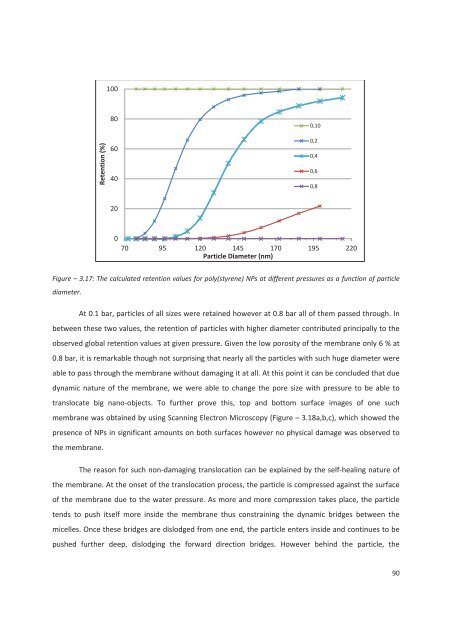4(%3)3 - Ecole nationale supérieure de chimie de Montpellier
4(%3)3 - Ecole nationale supérieure de chimie de Montpellier
4(%3)3 - Ecole nationale supérieure de chimie de Montpellier
You also want an ePaper? Increase the reach of your titles
YUMPU automatically turns print PDFs into web optimized ePapers that Google loves.
100Retention (%)8060400,100,20,40,60,820070 95 120 145 170 195 220Particle Diameter (nm)Figure – 3.17: The calculated retention values for poly(styrene) NPs at different pressures as a function of particlediameter.At 0.1 bar, particles of all sizes were retained however at 0.8 bar all of them passed through. Inbetween these two values, the retention of particles with higher diameter contributed principally to theobserved global retention values at given pressure. Given the low porosity of the membrane only 6 % at0.8 bar, it is remarkable though not surprising that nearly all the particles with such huge diameter wereable to pass through the membrane without damaging it at all. At this point it can be conclu<strong>de</strong>d that duedynamic nature of the membrane, we were able to change the pore size with pressure to be able totranslocate big nano-objects. To further prove this, top and bottom surface images of one suchmembrane was obtained by using Scanning Electron Microscopy (Figure – 3.18a,b,c), which showed thepresence of NPs in significant amounts on both surfaces however no physical damage was observed tothe membrane.The reason for such non-damaging translocation can be explained by the self-healing nature ofthe membrane. At the onset of the translocation process, the particle is compressed against the surfaceof the membrane due to the water pressure. As more and more compression takes place, the particletends to push itself more insi<strong>de</strong> the membrane thus constraining the dynamic bridges between themicelles. Once these bridges are dislodged from one end, the particle enters insi<strong>de</strong> and continues to bepushed further <strong>de</strong>ep, dislodging the forward direction bridges. However behind the particle, the90











